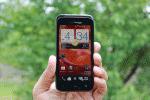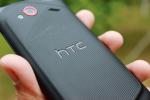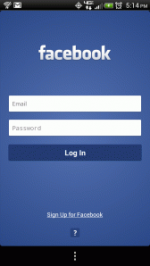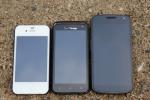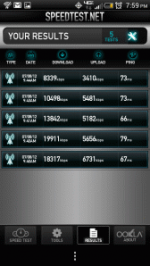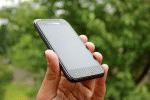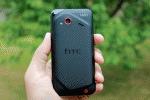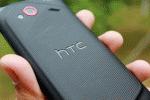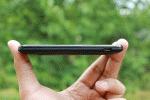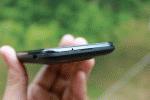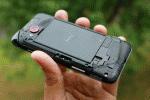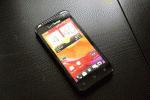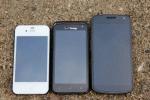 Short Version
Short VersionDoes bigger always mean better? It depends on who you ask of course, but more than a few major smartphone manufacturers would probably say yes. Even the notorious hold-outs at Apple are rumored to be working on something a bit larger than their usual — in short, the race to be the biggest doesn’t show any signs of letting up.
In a market where big smartphones reign supreme though, Verizon and HTC seem to think that a smaller device can still captivate some jaded consumers. As a result they’ve put together the Droid Incredible 4G LTE, a poorly named device that manages to squeeze a surprising amount of power into a relatively small frame.
Features:
- 4.0-inch qHD Super LCD display
- Runs Android 4.0.3 Ice Cream Sandwich and Sense 4.0
- 1.2 GHz dual-core Snapdragon S4 processor
- 1GB of RAM
- 8GB of onboard storage, accepts microSD cards as large as 32GB
- NFC
- 8-megapixel rear camera, VGA front-facing camera
- MSRP: $149 with a two-year contract, available as of July 5, 2012
Pros:
- Great Super LCD display
- Plenty of horsepower for daily tasks
- Solid build quality
Cons:
- Screen may seem too small for some
- Verizon loaded it up with quite a bit of bloatware
- It’s not terribly handsome
The first thing I noticed about about the Droid Incredible 4G LTE is just how small it felt in my hands. After months of toting around a Galaxy Nexus, it was actually kind of shocking. The Incredible 4G is just a hair wider than the iPhone 4S, but its taller stature and slightly narrower screen make it seem leaner than it actually is. Even so, the device has a well-constructed feel to it — it has a comforting heft to it and a quick bit of bending yielded none of the tell-tale creaking sounds that plague lower-end handsets.
At its thickest point the new Incredible comes in at 11.7mm — a far cry from the slim waistlines of HTC’s One S or the iPhone 4S, but it never feels like too much of a handful. That’s mostly thanks to the device’s curved back — like in the HTC Rezound before it, that curve helps the device from feeling too chunky.
The name of the design game here is nearly the same as it has been for nearly every other HTC/Verizon device in recent memory — the Incredible 4G’s rear is swathed in a matte black soft-touch plastic (warning: it picks up smudges easily), and the signature red trim around the camera lens makes a return after being left out of the Droid Incredible 2. Probably the most notable aspect of the Incredible 4G’s back plate though is the grippy, ridged finish that covers most of it — yet another design cue from the Rezound.
Aesthetically speaking, it’s not all old news — while the back has a matte finish, the device’s face is lined with a glossy gray plastic that helps break up the monotony. Most of the real estate is taken up by the device’s 4-inch Super LCD display (more on that later, naturally), and sitting below that is HTC’s now-standard row of three Android navigation keys — back, home, and recent apps. The front-facing VGA camera sits just above the screen, and north of those are a handsome red speaker grill, sleep/wake button, and headphone jack. The microUSB port is located on the Incredible 4G’s bottom left side, just opposite microSIM and microSD slots (though you’ll have to pop off that back plate to get to them).
All things considered, the Incredible 4G is solidly built, but it pales in comparison to the One series when it comes to looks. It’s actually quite a shame — with the One series, HTC has proven that it can design phones that look as good as they are constructed, but little of what they’ve learned has made the transition to the new Incredible. And it’s not as though the devices weren’t in the works at the same time — a very early version of the Incredible 4G was spotted back in February, right around when the One series made its debut at MWC 2012 in Barcelona.
SoftwareUnlike the last device I reviewed, I’m pleased to report that the Incredible 4G runs on Android 4.0 Ice Cream Sandwich, though it’s obscured a bit by HTC’s Sense 4.0 UI. If you’ve read Jordan’s HTC One S review, you’ll already have gotten the gist of Sense 4.0, but I’ll add that the latest version of Sense is far more tolerable than the versions that came before it.
That may not sound like much of a compliment, but coming from a person who thinks that Ice Cream Sandwich (and Jelly Bean, natch) are best left untouched, that statement carries more weight than it seems.
While previous iterations of Sense (especially Sense 3.0) seemed intent on wowing users with unnecessary graphical and UI flourishes that ultimately had a deleterious effect on performance, Sense 4.0 looks and feels much lighter and less obtrusive. There are plenty of thoughtful touches to be found here — the almost webOS-esque multitasking interface, the ability to edit the app tabs at the bottom of the launcher, the custom widget panel that pops up when long-pressing the homescreen, etc.
In a way, Sense has matured over these past few years, making it one of the better custom UIs that consumers. That being said, there are still some quirks to look out for and the device’s menu button situation immediately comes to mind. Unlike stock ICS, which often sees the menu’s soft key placed in either an app’s top or bottom navigation bar, HTC often gives the menu button a bar of its own to inhabit. It’s thoughtful, in a way — easy access to settings is always appreciated — but it just takes up more room than it’s worth. The keyboard is also remarkably similar to the Sense keyboard of yore, which I’ll admit I’ve never been a fan of.
What’s less tolerable is what Verizon has done to the Incredible 4G — unsurprisingly, the carrier has opted to load up the device with plenty of bloatware to contend with. Some of the offending bits like game demos are easily removed, but as usual preloaded Verizon utilities like My Verizon Mobile and the Verizon app store can’t be uninstalled. Fortunately, Sense allows for individual apps to be disabled and hidden from sight so it’s simple enough to clean house even though you can never really get rid of them (short of flashing a custom ROM).
Verizon seems to have done a bit of fiddling in other parts of the UI too: one of the tabs in the app launcher quickly brings up all of Verizon’s pre-installed nonsense, and users can keep their eyes peeled for persistent (and mildly obnoxious) notifications about their Wi-Fi status.
CameraHere’s the thing about the Incredible 4G’s camera — it sports an 8-megapixel rear sensor and the ImageSense camera UI like its cousins in the One series, but it doesn’t seem to have the discrete ImageChip that HTC is so proud of. That said, though, images were sharp and colors were vivid, there’s some distinct graininess when light levels dip.
HTC’s ImageSense UI makes up for things a bit by putting plenty of controls at the user’s fingertips without becoming overwhelming. Settings and scene modes are aligned vertically along the left side of the screen, while the shutter button, video toggle, and a full array of artsy filters can be accessed with one touch.
The Incredible 4G also shoots some impressive video, though there’s plenty of room for improvement. There’s plenty of wiggle to be seen even with the video stabilization option turned on, so users will have to be extra mindful so their recordings don’t turn into wobbling messes. On top of that, auto focus is awfully slow when recording video, so be prepared to tap-to-focus more often than not.
The end result is a very solid camera that could have been so much more. One last thing worth noting is that the Incredible 4G lacks a dedicated physical shutter button. Sure, the One X and the One S don’t have one either, but if Verizon and HTC were going to run with a completely different design, they could’ve improved things for the better a bit.
DisplayLet’s be real here: the screen is not going to work for everyone. It wasn’t that long ago that a 4-inch display would’ve gotten us phone geeks all hot and bothered, but those days have passed and the Incredible’s screen is left looking a little puny compared the flashy big guys on the market.
Say what you will about its size, but the Incredible 4G’s 4-inch Super LCD display is a very pleasant addition to the package. Colors were bright and well-reproduced, viewing angles were excellent, and visibility in sunlight was solid (though you’ll have to be mindful about cranking up the brightness).
Of course, some compromises had to be made. Unlike some of the 720p devices in roughly the same price range, the Incredible’s display runs at qHD resolution (960 x 540). It doesn’t squeeze as many pixels as some other device displays can — the Incredible 4G has a pixel density of 276 ppi, which bests the One S (256 ppi) but can’t touch the Galaxy S III’s 306 ppi. Still, that matters less on a smaller screen, and there was nary a jagged, pixellated edge to be found.
In the end, how much you or any other potential customer will like this phone depends a whole lot on your thoughts about screen size. That initial sense of screen-related claustrophobia subsided after a few days, but my heart ultimately still yearns for something bigger. If you’re thinking about picking one of these things up, do yourself a favor and play with it in person first.
PerformanceDon’t let its looks fool you — the Incredible 4G may be small, but it packs some considerable power under the hood thanks to its 1.2GHz Snapdragon S4 chipset (the Adreno 220 GPU doesn’t hurt either). From a purely anecdotal standpoint, I didn’t see a single hiccup as I swiped though the Incredible 4G’s menus and scrolled through long lists of links on a handful of websites. Similarly, the Incredible handled my usual test suite of HD videos and games with aplomb — this little guy has plenty of oomph.
The Incredible 4G’s average Quadrant score was 4098 — understandably not quite as high as the HTC One S (4371) since it sports a more robust spec sheet, but it’s awfully close. Meanwhile, it put the Galaxy Nexus (2730) to shame, though that seems to be a recurring trend with the devices I’ve played with recently. In short, the new Incredible should have no trouble keeping up with your daily grind.
Network performance was equally solid, with the Incredible 4G hitting an average of 14.2 Mbps down and 5.3 Mbps up in my quiet little corner of New Jersey. It goes without saying that your results be vary from mine (unless you live down the road, in which case you should come over and say “hi”), but Verizon’s network continues to be the one to beat if you’re looking for strong, widespread LTE coverage. In typical HTC fashion, call quality was remarkable as well — clear, crisp, and always loud enough.
What does miff me about the Incredible 4G is that it’s ostensibly meant to be a music-friendly device, but it’s stuck with a rather wimpy speaker on its rear end. I realize I may be picking nits here, but I long for the day that I review a device with a top-notch integrated speaker so jamming out on the go isn’t so problematic.
BatteryI wasn’t expecting much out of the Incredible 4G when it came to its removable 1700 mAh battery. My iffy past experiences with the original Incredible subconsciously soured me for the Incredible 4G’s potential, but it ended up performing better than I hoped. While using the Incredible 4G as my daily driver, I was easily able to get through an entire day of taking calls, firing off emails/texts, and sneaking in the occasional YouTube video before my battery went critical.
If you’re the type who just likes to sit around and fiddle with your phone all day, your results will obviously be a little different. In our typical stress test — in which display brightness is set to 50% and the device is set to repeat a series of Google Image Searches — the Incredible 4G lasted five hours and 12 minutes.
That’s not too shabby at all, and it compares favorably to both the One S (4:51) and the Galaxy S III (5:15). When it came to our video stress test, the Incredible 4G put up similar results. With display brightness set to 50% and volume cranked all the way up, it managed to play just a hair over five hours of nonstop video before finally giving up the ghost.
I don’t need to tell you that these sorts of intensive test results shouldn’t be taken as gospel, but combined with my day-to-day experience with the device, anyone who takes the plunge probably won’t have much to worry about on this front.
ConclusionI’ve come to really like the Droid Incredible 4G LTE, but it’s far from being a game-changer. That by itself isn’t a problem, but its lofty price tag doesn’t exactly help. At $149, the Droid Incredible 4G LTE is just a stone’s throw away from devices like the new Galaxy S III, which many have called the Android phone to beat.
It becomes difficult, then, to recommend something like the Incredible 4G when something exceptional can be had for nearly the same price, but bigger isn’t always better. If your mitts just can’t grapple with something like the Galaxy S III or Galaxy Nexus (or if you just prefer a phone that’s less conspicuous in your pocket), the Incredible 4G is an admirable choice in spite of its minor flaws.
